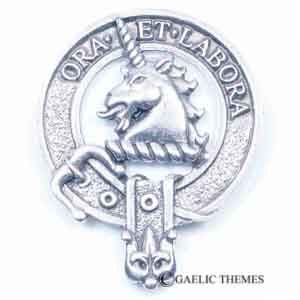Search
Ramsay
Select
- Design: Standard
- Clan Motto: Ora et labora (Pray and Work)
- Notes: Crest: A unicorn’s head couped Argent armed Or Symon de Ramesie was a Norman noble who accompanied David, Earl of Huntingdon north to Scotland in 1124. Symon received a grant from David for land in Midlothian. Symon also witnessed a charter to the monks of Holyrood in 1140. The de Ramesie family prospered. By the thirteenth century, there were five major branches: Dalhousie, Auchterhouse, Banff, Forfar, and Clatto. William de Ramsay of Dalhousie served on the king’s council during the minority of Alexander III. His son (or perhaps grandson), also named William, is listed on the Ragman Roll swearing fealty to Edward I of England in 1296. But Dalhousie later declared for the Bruce and was one of the signatories of the Declaration of Arbroath - the 1320 letter to the pope which declared the independence of Scotland. In 1400, Sir Alexander Ramsay held Dalhousie Castle in Midlothian against a siege by Henry IV of England -- well enough that the English withdrew. Hid descendant and namesake, Alexander was killed at Flodden in 1513. Dalhousie passed to his son Nicolas who became a strong supporter of Mary Queen of Scots. After her defeat, the Ramsays acknowledged her son as James VI. Later, they would be well rewarded for saving this monarch’s life. In 1600, John Ramsay, great-grandson to Nicolas, killed the Earl of Gowrie and his brother, Alexander Ruthven, after a plot to kidnap the king came to light (the Gowrie Conspiracy). John was created Earl of Holderness and Viscount Haddington. William Ramsay was created Earl in 1633. Even so, he sided with Parliament against Charles I and raised a cavalry regiment. He fought with General Lesley at Philiphaugh in 1645 where he surprised Montrose. Down to the present day, Ramsays have been active in public service and the military. They have served in all the great campaigns of the 18th and 19th centuries on the Continent, in Canada and in India. For example. the ninth earl was Governor of Canada from 1819 to 1828, and Commander-in-chief of India from 1829 to 1832. His son served as Governor General of India from 1847 to 1856 and was created Marquess of Dalhousie in 1849. Dalhousie Castle is now a hotel. The chief seat is Brechin Castle in Angus.
Product Name
Price Starts At
$59.99
$34.99
$219.99
Product Name
Price Starts At
$39.99
$129.99
